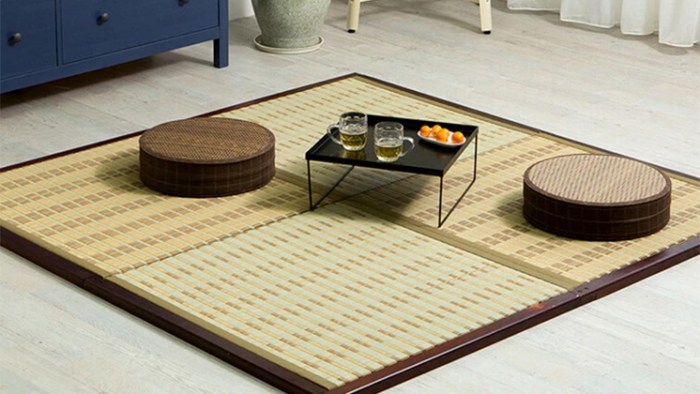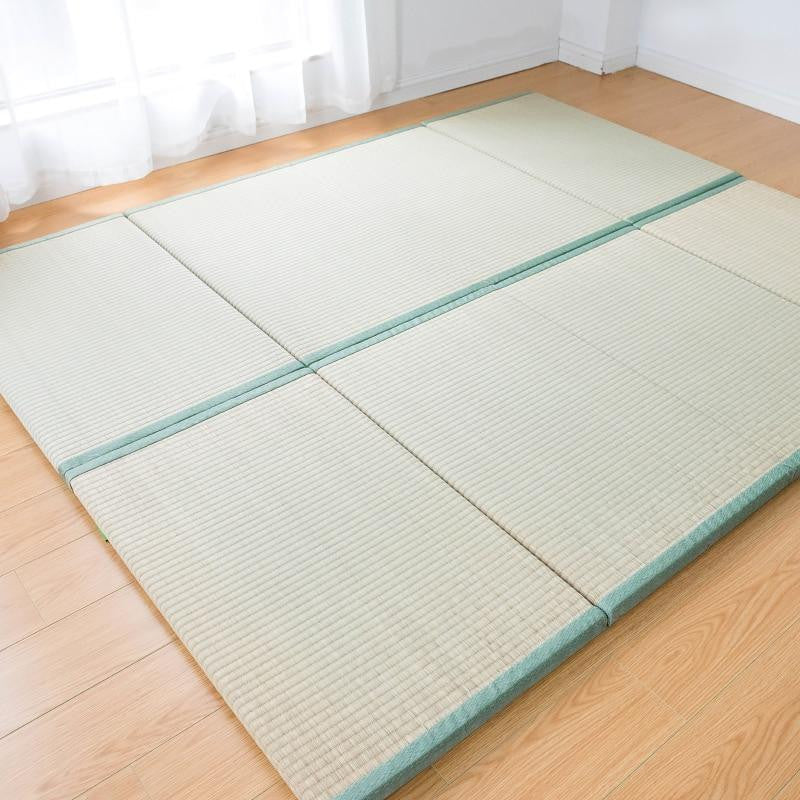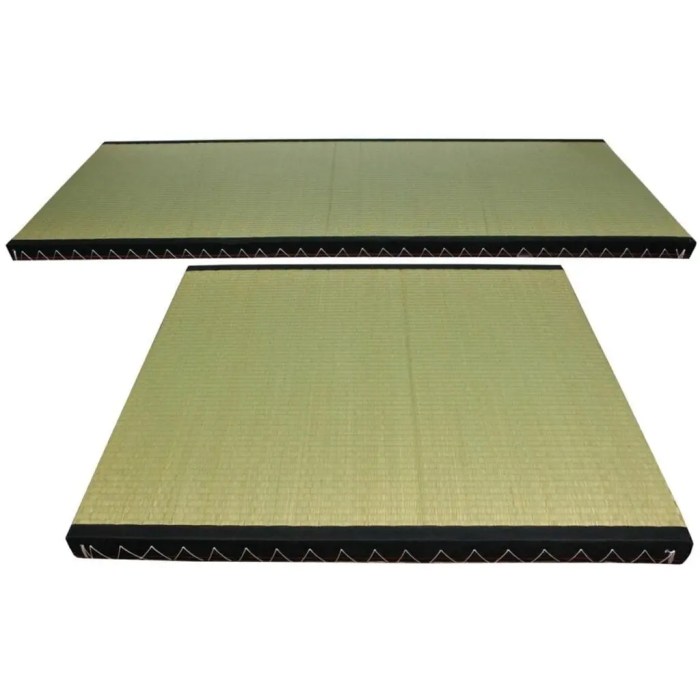Tatami mats, an integral part of Japanese culture, have a rich history and versatile applications. From their humble origins as flooring in traditional homes to their modern use in martial arts and contemporary design, tatami mats continue to captivate with their unique charm and functionality.
Crafted from natural materials like rice straw and rush grass, tatami mats are meticulously woven using traditional techniques that have been passed down through generations. Their standard dimensions and distinct styles reflect the meticulous attention to detail that characterizes Japanese craftsmanship.
Tatami Mat History

Tatami mats, an iconic element of Japanese culture, have a rich history deeply intertwined with the nation’s traditions and way of life. Originating in ancient Japan, these mats evolved from simple rice straw coverings to become integral to Japanese architecture, aesthetics, and rituals.
Tatami mats, traditional Japanese flooring, exude an air of tranquility. To enhance their ambiance, consider incorporating a floor lamp that casts a warm glow. The diffused light will complement the natural texture of the tatami, creating an inviting and serene atmosphere.
Origins and Evolution
The earliest tatami mats, known as “tatami omote,” were likely used as floor coverings in elevated buildings during the Yayoi period (300 BCE – 300 CE). Made from woven rice straw, they provided insulation and comfort in homes and palaces.
Tatami mats are a traditional Japanese flooring material made from woven rice straw. They are known for their durability and comfort, and they can be used in a variety of settings, including bedrooms, living rooms, and tea rooms. One popular use for tatami mats is as a base for a floor bed base . Floor bed bases are a great way to create a comfortable and stylish sleeping space, and they can be used with or without a mattress.
Tatami mats provide a firm and supportive surface for sleeping, and they can help to regulate body temperature. They are also a natural material that is hypoallergenic and resistant to dust mites.
Over time, the mats became standardized in size and shape, with the traditional “jo” (unit of measurement) emerging during the Heian period (794 – 1185 CE).
Cultural Significance
In Japan, tatami mats hold immense cultural significance. They are not merely floor coverings but represent a way of life. In traditional Japanese architecture, tatami mats define the size and layout of rooms, creating a sense of harmony and order.
The mats’ natural, earthy tones and textures evoke a sense of tranquility and connection to nature.
Tatami Mat Materials and Construction
The construction of tatami mats involves the use of specific materials and traditional techniques. Understanding these elements is crucial for appreciating the craftsmanship and durability of these unique floor coverings.
Materials
The primary materials used in the construction of tatami mats are rice straw and rush grass, known as igusa. Rice straw, the inner core of rice stalks, provides the core and rigidity of the mat. Rush grass, with its long, fibrous blades, is woven around the rice straw to create the surface and provide a comfortable, resilient texture.
Construction Methods
The traditional methods of weaving and binding tatami mats have been passed down through generations of skilled artisans. The process begins with the preparation of the rice straw, which is dried and bundled into small sheaves. These sheaves are then arranged in a specific pattern and bound together with twine.
The rush grass is then woven around the rice straw core, using a unique interlocking technique that ensures durability and flexibility.
Tatami Mat Dimensions and Styles
Tatami mats have standardized dimensions that ensure consistency and functionality within traditional Japanese architecture. The standard size of a tatami mat is approximately 90 centimeters (35.4 inches) wide and 180 centimeters (70.9 inches) long. This size has been established over centuries of use and is considered ideal for providing comfortable seating and sleeping arrangements.
In addition to the standard size, there are also variations in tatami mat styles. These styles differ in their construction and appearance, catering to specific preferences and purposes.
Omote
Omote is the most common type of tatami mat. It features a woven surface made of natural rush grass, providing a smooth and durable surface. Omote mats are typically used in traditional Japanese rooms, tea ceremonies, and martial arts studios.
Nakabori
Nakabori tatami mats have a unique construction where the rush grass is woven in a grid pattern. This creates a textured surface that provides additional traction and support. Nakabori mats are often used in areas with high foot traffic, such as hallways and entryways.
Goza
Goza tatami mats are lightweight and portable, making them ideal for temporary seating or sleeping arrangements. They are typically made of a woven rush grass or other natural materials and are often used in outdoor settings or during special occasions.
Tatami Mat Uses and Applications
Traditionally, tatami mats were used in Japanese homes as flooring and seating. They were also used in temples and shrines as a place to sit or kneel during religious ceremonies. In modern times, tatami mats have been adapted for a variety of uses, including:
Martial Arts
Tatami mats are commonly used as flooring for martial arts such as judo, karate, and aikido. The mats provide a soft, shock-absorbing surface that helps to prevent injuries during falls and throws.
Flooring, Tatami mat
Tatami mats can be used as flooring in homes, offices, and other commercial spaces. They are a durable and easy-to-clean option that can add a touch of traditional Japanese style to any space.
Tatami Mat Care and Maintenance

Preserving the quality and longevity of tatami mats requires proper care and maintenance. Regular cleaning, airing, and rotation are crucial to ensure they remain in pristine condition.
Cleaning tatami mats involves gentle sweeping or vacuuming to remove dust and debris. Avoid using harsh chemicals or abrasive cleaners, as these can damage the delicate surface of the mats. For spills or stains, blot them immediately with a clean, damp cloth and allow the area to air dry.
Regular Airing
Regular airing is essential for preventing moisture accumulation and the growth of mold and mildew. Open windows and doors to allow fresh air to circulate through the room where the tatami mats are installed. If possible, remove the mats and place them outside in a shaded area for several hours to thoroughly air them out.
Traditional tatami mats, crafted from woven rushes, have long been a staple in Japanese homes. However, for those seeking a more modern alternative, foldable mattresses offer a practical and comfortable solution. These mattresses, made from high-density foam or memory foam, provide excellent support and can be easily folded and stored when not in use.
Despite their modern design, foldable mattresses retain the same versatility as tatami mats, allowing for various uses, from sleeping to sitting and relaxing.
Rotation
Rotating tatami mats periodically helps distribute wear and tear evenly, preventing premature aging or damage to specific areas. To rotate the mats, simply lift them and swap their positions. It’s recommended to rotate the mats every six months to a year, depending on usage and traffic.
Final Thoughts: Tatami Mat

Whether adorning the floors of temples or providing a comfortable surface for martial arts practice, tatami mats embody the harmony between tradition and modernity. Their enduring popularity is a testament to their timeless beauty and versatility, making them an enduring symbol of Japanese culture.
FAQ Compilation
What is the significance of tatami mats in Japanese culture?
Tatami mats hold deep cultural significance in Japan, representing tradition, cleanliness, and respect. They are used in various settings, from homes to temples, and their presence evokes a sense of tranquility and order.
How are tatami mats made?
Tatami mats are crafted from natural materials such as rice straw or rush grass. The core is bound together with twine and then covered with a woven matting called omote. The omote can be made from various materials, including soft rush, paper, or vinyl.
What are the different types of tatami mats?
There are several types of tatami mats, each with unique characteristics. Omote mats are the most common, featuring a soft rush covering. Nakabori mats have a recessed center section, while goza mats are smaller and more portable.
How do you care for tatami mats?
Regular maintenance is crucial to preserve the quality of tatami mats. They should be aired out frequently and rotated to prevent uneven wear. Spills should be cleaned promptly using a damp cloth. Avoid using harsh chemicals or excessive moisture.